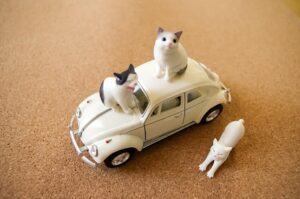You might have occasions where you need to take your cat in the car, such as moving with your cat or taking them to a distant veterinary clinic.
One thing to be cautious about during such times is "motion sickness in cats."
In fact, cats, like humans, can experience motion sickness due to the vibrations and movements of the car. Motion sickness can be very uncomfortable for cats.
So, in this article, we will introduce measures to prevent motion sickness in cats.
Table of Contents
1. Cats Can Get Motion Sickness
2. Symptoms of Motion Sickness
∟2-1. Restlessness
∟2-2. Excessive Drooling and Panting
∟2-3. Accidents
∟2-4. Vomiting and Diarrhea
3. Prevention of Motion Sickness and 8 Points to Consider When Taking Cats in the Car
∟3-1. Get the Cat Used to the Car
∟3-2. Pay Attention to the Smell Inside the Car
∟3-3. Feed the Cat 6 Hours Before the Trip
1. Cats Can Get Motion Sickness

Cats are said to be more resistant to motion sickness compared to dogs because they have a well-developed vestibular system, which controls balance. However, it doesn't mean that cats are completely immune to motion sickness.
Cats' motion sickness is similar to humans and can be triggered by the vibrations and movements of the car, affecting their vestibular system.
The causes of motion sickness in cats include:
- - Car movements and speed
- - Stress from unfamiliar car rides
- - Odors inside the car
- - Temperature inside the car
Whether a cat experiences motion sickness or not can vary from one individual to another. However, cats that are particularly timid, sensitive to stress, and prone to changes in their environment are more likely to experience motion sickness.
When taking your cat in the car, it's essential to consider both their physical condition and personality.
2. Symptoms of Motion Sickness

If you notice the following behaviors in your cat while riding in a car, there is a possibility that they are experiencing motion sickness:
- - Restlessness
- - Frequent yawning
- - Excessive drooling
- - Panting (heavy breathing)
- - Accidents
- - Vomiting and diarrhea
Now, let's take a closer look at each of these symptoms.
2-1. Restlessness
Restlessness is a common symptom of motion sickness in cats.
Extreme anxiety can lead to restlessness, causing your cat to scratch at their carrier bag, vocalize anxiously, or exhibit other anxious behaviors. If you notice these symptoms, it could be a sign of motion sickness.
Yawning may also be observed, which is another sign of discomfort. In such cases, it's advisable to stop the car and let your cat rest.
2-2. Excessive Drooling and Panting
If your cat starts drooling excessively or panting during the car ride, it could be due to motion sickness.
Excessive drooling can be messy, and panting is a sign that your cat is stressed and trying to cool down. These symptoms can be distressing for both the cat and the owner.
If you notice these signs, it's essential to provide comfort to your cat and consider taking a break.
2-3. Accidents
In some cases, cats may have accidents inside the car when experiencing motion sickness.
This can be a challenging situation for both you and your cat. To prevent accidents, it's crucial to prepare for the trip adequately and monitor your cat's behavior.
2-4. Vomiting and Diarrhea
Vomiting and diarrhea are severe symptoms of motion sickness in cats.
If your cat vomits or has diarrhea during the car ride, it's a clear indication of motion sickness. In such cases, it's crucial to clean up the mess promptly and ensure your cat's comfort.
3. Prevention of Motion Sickness and 8 Points to Consider When Taking Cats in the Car
Now that we've discussed the causes and symptoms of motion sickness in cats, let's explore how to prevent it and ensure a comfortable car ride for your feline friend.
3-1. Get the Cat Used to the Car
To reduce the chances of motion sickness, it's essential to get your cat accustomed to the car gradually.
Start by letting your cat explore the stationary car while it's parked in the driveway or garage. Allow your cat to enter the car voluntarily and investigate its surroundings at their own pace.
Next, start the car engine without going anywhere and let your cat get used to the sound and vibration. You can reward your cat with treats or playtime inside the car to create positive associations.
Gradually increase the duration of these sessions and take short drives around the neighborhood before embarking on longer trips.
3-2. Pay Attention to the Smell Inside the Car
Unpleasant smells inside the car can contribute to motion sickness in cats.
Make sure the car interior is clean and free of any strong odors, such as cleaning products or air fresheners that may be overwhelming for your cat's sensitive sense of smell.
3-3. Feed the Cat 6 Hours Before the Trip
Feeding your cat a large meal just before the trip can increase the chances of motion sickness.
Instead, feed your cat a light meal 6 hours before the journey to allow enough time for digestion. This can help prevent nausea and discomfort during the car ride.
3-4. Use a Carrier Bag
Using a carrier bag or crate can provide a sense of security for your cat during the car ride.
Make sure the carrier is well-ventilated and comfortable for your cat. Place familiar bedding and toys inside the carrier to make it a cozy.



